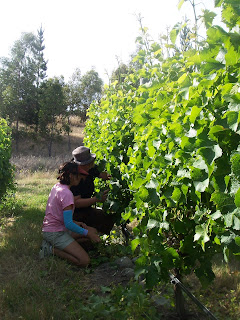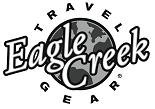Given New Zealand's abundant farming lifestyle, livelihoods tied to land, and the open armed graciousness often found in small towns grounded by nature, a volunteer program called WWOOF (World Wide Organization of Organic Farmers) is quite popular among backpackers in New Zealand. This organization supports a wide variety of homestays in exchange for help around the "farms". It was an ideal opportunity for Christy to fulfill her long time aspiration of "working"on a vineyard and Dion, always eager to get involved & his hands dirty,was excited to imbibe something new as well.
New Zealand has made its way on the wine map with Sauvignon Blancs, particularly in the Marlborough Region (on the South Island) where we did our one week homestay at Clos Marguerite vineyard and winery. Considered tiny among the other wineries in the region (approx. 3500 cases per year), Clos Marguerite is family run- by husband and wife, Marguerite and Jean-Charles, a Belgian couple who moved to New Zealand 12 years ago with their then 3 and 6 year old children.
For our stay, as Jean-Charles was in Europe, Marguerite and her two kids, Marin and Sybil were our ever so gracious hosts. Set among 20 acres of Sauvignon Blanc and Pinot Noir vines, on a terrace above the Awatere River, is their home, a small warehouse sized winery, a narrow field for their sheep and Max's therobred horse, and our studio/shed. The location was pinpointed by Jean Charles, who recognized that the self draining soil properites would be just right for the Sauvignon grapes.
Our seven days WWOOFING began with breakfast 7:30am at the house with Marguerite: yogurt with trail mix Cereal, toast and tea. Each day our tasks varied; plucking leaves from the Sauvignon Blanc vines was the most harrowing job. Fearful of pruning too much or too little, our pace was quite slow.. so we plucked on unrequested afternoon shifts and overall it took us 2 days for a job that would have taken any of them one. Another day we tidied root stalk, trimming the overgrown vines and lacing them into the support wires to grow properly and strong. Such behind the scene labor can not be glamorized and is therefore often forgotten when appreciating a glass of wine. It's these tedious, labor intensive, ache inducing details however that make family run wineries produce a quality and standard of wine lost in the "factory" imported wine we are most familiar with. Marguerite impressed on us how every single thing; from thickness of each layer of soil, to how much breeze flows within the leaves, to the ratio of grape skin pressed, helps to create each bottle of wine. We were not surprised to genuinely enjoy both their wines- far more even than the varietals we later tried when we did our wine trail tour. Fortunately for us, Clos Marguerite is exported to the US.. and quite popular. Wine Enthusiast awarded their 2006 Sauvignon Blanc an impressive 90 in their Nov 06 issue.
As it is summer here in New Zealand, daylight lasts until 9pm so each day we also relished the area by reading with the view, playing in the river, and riding bikes to the Ocean and along endless roads of vineyards and rolling hills.


 The Clos Marguerite vineyard, winery and family home
The Clos Marguerite vineyard, winery and family home


 Our first two days were spent plucking leaves from the vines to allow for more breeze, yet careful to not expose the grapes to too much direct sun.
Our first two days were spent plucking leaves from the vines to allow for more breeze, yet careful to not expose the grapes to too much direct sun.

 Working on other tasks: weeding the vegetable garden and cleaning the buckets they collect the grapes in come harvest time.
Working on other tasks: weeding the vegetable garden and cleaning the buckets they collect the grapes in come harvest time. 

 Wine was only part of our experience WWOOFING. Marguerite is a wonderful cook and therefore spoiled us with delicious dinners each night, usually coupled with a cooking lesson. "Tea"(aka dinner) was a group effort... starting with feeding the sheep, (eventually lamb we ate), pulling potatoes and vegetables from the garden, and grilling or cooking together in the kitchen. As our appreciation for homegrown produce grew (starting with reading Omnivore's Dilemma on this trip), it was a welcomed task to weed the vegetable garden two different days. Far from Manhattan and South Beach, we got our hands deep down in soil and felt the gratification gardener's get from destroying the pestuous invasion of weeds, and then eating the fresh, organic "fruits"of your labor.
Wine was only part of our experience WWOOFING. Marguerite is a wonderful cook and therefore spoiled us with delicious dinners each night, usually coupled with a cooking lesson. "Tea"(aka dinner) was a group effort... starting with feeding the sheep, (eventually lamb we ate), pulling potatoes and vegetables from the garden, and grilling or cooking together in the kitchen. As our appreciation for homegrown produce grew (starting with reading Omnivore's Dilemma on this trip), it was a welcomed task to weed the vegetable garden two different days. Far from Manhattan and South Beach, we got our hands deep down in soil and felt the gratification gardener's get from destroying the pestuous invasion of weeds, and then eating the fresh, organic "fruits"of your labor.  Every night was a different, yet still spectacular sunset.
Every night was a different, yet still spectacular sunset.


 Our last day in this region of New Zealand we spent in Renwick, about 30km from Clos Marguerite where we rented bikes and did an informal tasting tour at 8 wineries. The highlight of the day however was our picnic by the river, with a newly purchased NZ Chardonnay from Bouldevines Vineyard.
Our last day in this region of New Zealand we spent in Renwick, about 30km from Clos Marguerite where we rented bikes and did an informal tasting tour at 8 wineries. The highlight of the day however was our picnic by the river, with a newly purchased NZ Chardonnay from Bouldevines Vineyard.
 Driving the Southern Coastal Route around the base of the South Island. The wind was not blowing fierce this day but the trees permanently lean from a constant sea breeze.
Driving the Southern Coastal Route around the base of the South Island. The wind was not blowing fierce this day but the trees permanently lean from a constant sea breeze.



 Overlooking Nugget Point (named after these rock formations that resemble gold nuggets). We saw penguins at the neighboring bay after this walk- as the penguins emerge from the sea roughly 2-3 hours before dusk each night (ie. 7-8pm this season).
Overlooking Nugget Point (named after these rock formations that resemble gold nuggets). We saw penguins at the neighboring bay after this walk- as the penguins emerge from the sea roughly 2-3 hours before dusk each night (ie. 7-8pm this season). Sunset from our Backpackers B&B on the Scenic Reserve
Sunset from our Backpackers B&B on the Scenic Reserve St. Joseph's Cathedral in Dunedin and view from our loft at Hogwartz
St. Joseph's Cathedral in Dunedin and view from our loft at Hogwartz Celebrating Aussie Day (the hat is rewarded to those tables that drink 5+ pints in the course of the day)
Celebrating Aussie Day (the hat is rewarded to those tables that drink 5+ pints in the course of the day) Tasting at Speight's Brewery... the following day
Tasting at Speight's Brewery... the following day








































 The Clos Marguerite vineyard, winery and family home
The Clos Marguerite vineyard, winery and family home






 Wine was only part of our experience WWOOFING. Marguerite is a wonderful cook and therefore spoiled us with delicious dinners each night, usually coupled with a cooking lesson. "Tea"(aka dinner) was a group effort... starting with feeding the sheep, (eventually lamb we ate), pulling potatoes and vegetables from the garden, and grilling or cooking together in the kitchen. As our appreciation for homegrown produce grew (starting with reading Omnivore's Dilemma on this trip), it was a welcomed task to weed the vegetable garden two different days. Far from Manhattan and South Beach, we got our hands deep down in soil and felt the gratification gardener's get from destroying the pestuous invasion of weeds, and then eating the fresh, organic "fruits"of your labor.
Wine was only part of our experience WWOOFING. Marguerite is a wonderful cook and therefore spoiled us with delicious dinners each night, usually coupled with a cooking lesson. "Tea"(aka dinner) was a group effort... starting with feeding the sheep, (eventually lamb we ate), pulling potatoes and vegetables from the garden, and grilling or cooking together in the kitchen. As our appreciation for homegrown produce grew (starting with reading Omnivore's Dilemma on this trip), it was a welcomed task to weed the vegetable garden two different days. Far from Manhattan and South Beach, we got our hands deep down in soil and felt the gratification gardener's get from destroying the pestuous invasion of weeds, and then eating the fresh, organic "fruits"of your labor.  Every night was a different, yet still spectacular sunset.
Every night was a different, yet still spectacular sunset.




